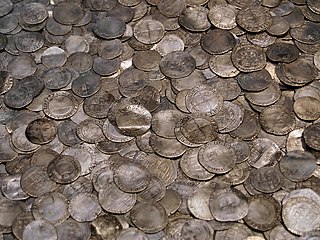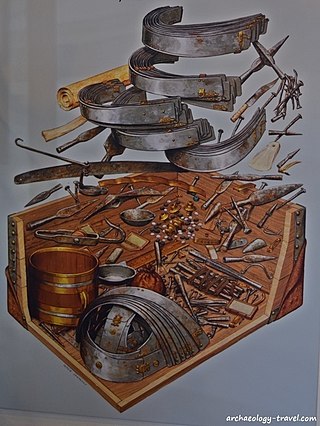
The British Museum is a public museum dedicated to human history, art and culture located in the Bloomsbury area of London. Its permanent collection of eight million works is the largest in the world. It documents the story of human culture from its beginnings to the present. The British Museum was the first public national museum to cover all fields of knowledge.

The Mildenhall Treasure is a large hoard of 34 masterpieces of Roman silver tableware from the fourth century AD, and by far the most valuable Roman objects artistically and by weight of bullion in Britain. It was found at West Row, near Mildenhall, Suffolk, in 1942. It consists of over thirty items and includes the Great Dish which weighs over 8 kg (18 lb).

A hoard or "wealth deposit" is an archaeological term for a collection of valuable objects or artifacts, sometimes purposely buried in the ground, in which case it is sometimes also known as a cache. This would usually be with the intention of later recovery by the hoarder; hoarders sometimes died or were unable to return for other reasons before retrieving the hoard, and these surviving hoards might then be uncovered much later by metal detector hobbyists, members of the public, and archaeologists.


The Seuso Treasure or Sevso Treasure, is a hoard of silver objects from the late Roman Empire. The first pieces appeared on the market in London in 1980, and the treasure was acquired by a consortium headed by Spencer Compton, 7th Marquess of Northampton. Documentation was provided in which it was stated that it had been found in the Tyre and Sidon regions of Lebanon. It was put up for sale in New York City in 1990 by Sotheby's, but was halted when the documentation was found to be false, and the governments of Hungary, Yugoslavia and Lebanon made claims of ownership. The claims of ownership by these countries were rejected by a US court, and the treasure remained in the possession of the Marquess of Northampton. Scotland Yard still has an open case on the matter.

The Corbridge Hoard is a hoard of mostly iron artefacts that was excavated in 1964 within the Roman site of Coria, next to what is now Corbridge, Northumberland, England.

The Antalya Museum or Antalya Archeological Museum is one of Turkey's largest museums, located in Konyaaltı, Antalya. It includes 13 exhibition halls and an open air gallery. It covers an area of 7,000 m2 (75,000 sq ft) and 5000 works of art are exhibited. In addition a further 25,000–30,000 artifacts which cannot be displayed are in storage. As a museum exhibiting examples of works, which illuminate the history of the Mediterranean and Pamphylia regions in Anatolia, Antalya Museum is one of the most important of Turkey's museums. The Museum won the "European Council Special Prize" in 1988.
The Risley Park Lanx is a large Roman silver dish that was discovered in 1729 in Risley Park, Derbyshire, and was later lost from view. In Roman times, a lanx was generally a large serving platter, about 15 by 20 inches in size. Particularly ornamented ones were used to make offerings or sacrifices. The inscription on the Risley Park Lanx suggests it was used as "church plate".

A lanx was a large ancient Roman serving platter. Particularly ornamented ones were used to make offerings or sacrifices. Indeed, the silver Corbridge Lanx, the second discovered in Britain, has depicted on it a lanx itself, set beside various gods and goddesses: Minerva, Diana, Juno, Vesta and Apollo.

The Esquiline Treasure is an ancient Roman silver treasure that was found in 1793 on the Esquiline Hill in Rome. The hoard is considered an important example of late antique silver work from the 4th century AD, probably about 380 for the major pieces. Since 1866, 57 objects, representing the great majority of the treasure, have been in the British Museum.

The Mâcon Treasure or Macon Treasure is the name of a Roman silver hoard found in the city of Mâcon, eastern France in 1764. Soon after its discovery, the bulk of the treasure disappeared, with only 8 silver statuettes and a silver plate identified as being part of the original find. All of these objects are now in the British Museum

The Chaourse Treasure is a hoard of Roman silver found in Chaourse, a village near Montcornet, Aisne in northern France in 1883. Dating between the 2nd and 3rd centuries AD, the treasure is one of the most complete table services to survive from antiquity. This important hoard is now part of the British Museum's collection.

The Caubiac Treasure is a Roman silver hoard found in the village of Thil, southern France in 1785 that is now kept in the British Museum in London.

The Chatuzange Treasure is the name of an important Roman silver hoard found in the village of Chatuzange-le-Goubet in the department of Drôme, south-eastern France. Since 1893 it has been part of the British Museum's collection.

The Carthage Treasure is a Roman silver hoard, which was found in Tunis, Tunisia, at the site of the ancient city of Carthage. The treasure principally consists of silver tableware and jewellery, most of which is now held at the British Museum.

The Lampsacus Treasure or Lapseki Treasure is the name of an important early Byzantine silver hoard found near the town of Lapseki in modern-day Turkey. Most of the hoard is now in the British Museum's collection, although a few items can be found in museums in Paris and Istanbul too.

The Paramythia Hoard or Paramythia Treasure is the name of a Greco-Roman hoard of bronze figurines and other objects found in Paramythia, north-west Greece in the late 18th century. Of the original nineteen objects found in the hoard, fourteen are now in the British Museum

The Capheaton Treasure is an important Roman silver hoard found in the village of Capheaton in Northumberland, north-east England. Since 1824, it has been part of the British Museum's collection.

The Bursa Treasure or Brusa Treasure is the name of an early Roman silver hoard found in the city of Bursa, Turkey. Since 1913, the entire treasure has been at the British Museum.

The Boscoreale Treasure is a large collection of exquisite silver and gold Roman objects discovered in the ruins of the ancient Villa della Pisanella at Boscoreale, near Pompeii, southern Italy. Consisting of over a hundred pieces of silverware, as well as gold coins and jewellery, it is now mostly kept at the Louvre Museum in Paris, although parts of the treasure can also be found at the British Museum.



















